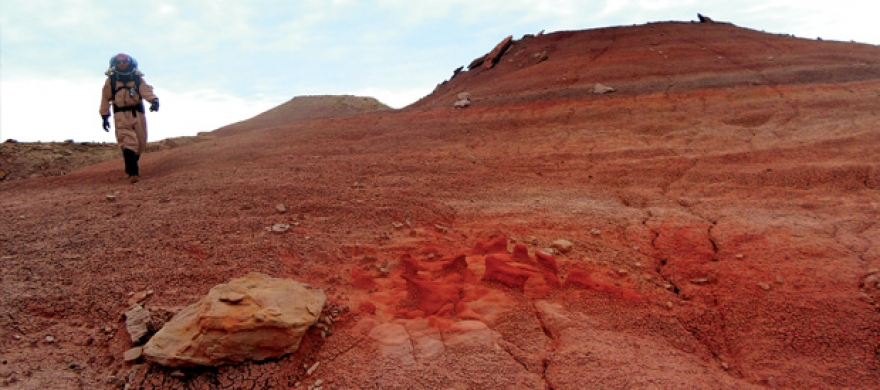Derek On Mars
A GSEP student embarks on an out of this world journey to influence the future of space exploration
"There were footprints in the fresh snow and fossils in the rocks. Who was here before us? None of us wanted to return to the habitat, but one crew member had severe condensation in the mask. Safety first. Maybe it’s still the rush of what we are doing here, but I would not trade this experience for anything."
Derek Pelland awoke abruptly early Christmas Eve morning on Mars. He had minutes to
prepare a scouting vehicle that would explore the terrain outside the research habitat—his
home for only six more days. When he received word of the reconnaissance and surveillance
mission, the former marine instinctively suited up to lead the expeditionary portion
of a four-person, pedestrian extravehicular activity (EVA) to “Teetering Rock,” a
random scattering of fallen rocks with others towering above. The purpose of the mission:
to determine if the crew would be able to later deploy a long-duty mission EVA to
the plateau.
The entire crew of six aboard the Mars Desert Research Station (MDRS), a simulation
habitat operated by the Mars Society, worked together to outfit those assigned to
the mission. They lent extra hands and eyes to check the vital equipment and fittings
before sending them out into the cold, barren, desert-like environment of southern
Utah— an Earth landscape that closely mirrors the harsh terrain of the Red Planet.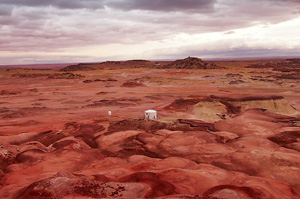 One of the crew’s most important tasks while at the MDRS was research and development
of exploration equipment, including space suits. They also studied food intake and
the effects on the mind and body of being in a confined space. “We did sleep studies
to measure deprivation, food studies to measure how people were responding to the
different types of food and restrictions. All of these were intended to prepare future
missions to Mars.”
One of the crew’s most important tasks while at the MDRS was research and development
of exploration equipment, including space suits. They also studied food intake and
the effects on the mind and body of being in a confined space. “We did sleep studies
to measure deprivation, food studies to measure how people were responding to the
different types of food and restrictions. All of these were intended to prepare future
missions to Mars.”
Given the opportunity to develop their own science research projects, the crew worked
on finding different types of gear to aid in geological missions. “We would collect
all of these geological objects and it was not always an easy task. Our geologist
and physicist made recommendations for enhancing the tools that we had and exploring
the different landscapes around the area so the next crew could pick up where we left
off,” Pelland explains.
"The Moon was so bright, I could hardly contain myself after realizing how majestic
it really is when you can see the dips and dots, flowing craters, and experience its
glowing comforts. Thanks, Santa, I got exactly what I wanted for Christmas: holiday
on Mars!"
As a child, Pelland dreamt of becoming an astronaut. It always seemed like a far-
reaching goal, but he always believed, even a little bit, that he could get to it.
To satisfy his expeditious spirit, he climbed the ranks to become an Eagle Scout and,
later, joined the U.S. Marines, where he completed missions around the world.
After completing his bachelor’s degree in social sciences at the University of Michigan
and receiving a scholarship to attend graduate school at USC, Pelland became a high
school professor at a dropout recovery center in Los Angeles and enrolled in GSEP’s
Social Entrepreneurship and Change program. While looking into PhD programs in educational
psychology at Stanford last summer, Pelland discovered Stanford’s NASA facility.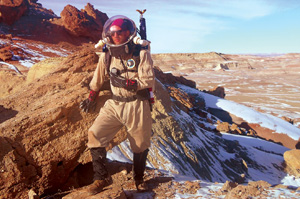 “At the time, the Endeavour space shuttle was flying over my house in Manhattan Beach,
so I rode my bike to LAX and watched it land,” Pelland recalls. The event reignited
a childhood curiosity and passion for astronomy and the aerospace industry, leading
Pelland deeper into his pursuit. He soon found an application to apply to the Mars
Desert Research Program.
“At the time, the Endeavour space shuttle was flying over my house in Manhattan Beach,
so I rode my bike to LAX and watched it land,” Pelland recalls. The event reignited
a childhood curiosity and passion for astronomy and the aerospace industry, leading
Pelland deeper into his pursuit. He soon found an application to apply to the Mars
Desert Research Program.
The application promised a two-week experience to simulate and train for future missions
to Mars. Pelland already knew he was well equipped with the skills and techniques
necessary for an expedition of this magnitude. All he needed were recommendations
and signatures—a lot of them—to vouch for his ability to take on the ambitious assignment.
A few months later, after spending just one day working on his application at a local
coffee shop and contacting former military commanders for recommendations, he got
the e-mail he was waiting for: he had been selected to be the executive officer of
the Campus Martius crew that would take off for “Mars” on December 15. Space was finally
within reach.
"I was able to quickly move across the snowy terrain of washouts, ridges, flat prairie
and onto the canyon-like peaks off the western corridor of where our capsule lies.
“The middle of nowhere,” perhaps some of the prehistoric footpaths taken by ancient
species of dinosaurs. I admit I was slightly winded, but this view certainly stole
my breath..."
Because of the habitat’s prime location atop the Morrison Formation, a late Jurassic
sedimentary rock sequence dating back roughly 150 million years, the crew spent most
of their research time hunting for geological specimens. They uncovered mollusk shells
from the Gryphaeidae family, which, according to Pelland, indicates the existence
of an ancient seabed in the Dakota Sandstone region dating back 66-100 million years.
After a day of EVA, the crew took to the laboratory to analyze their findings, mostly
minerals, petrified wood, and fossil soils dating back 66–100 million years. “We recorded
the variance in strata; noting the changes in substrate characteristics. We also used
the microscope to analyze the rock samples from EVA missions and view their morphological
structure,” explains Pelland on the crew’s Final Mission Report.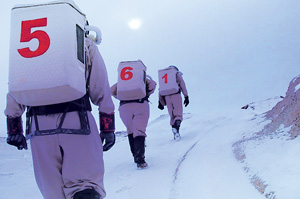 On other scientific missions, the crew used U.S. Coast Guard maps and handheld GPS
units to traverse the rough land and was able to send three mounted ATV EVA missions.
“The mobility added was extremely useful to us as we were able to cover a much larger
distance and conserve energy, as we did not have to walk out to the sites and then
explore on foot,” Pelland observes.
On other scientific missions, the crew used U.S. Coast Guard maps and handheld GPS
units to traverse the rough land and was able to send three mounted ATV EVA missions.
“The mobility added was extremely useful to us as we were able to cover a much larger
distance and conserve energy, as we did not have to walk out to the sites and then
explore on foot,” Pelland observes.
Strong winds and dangerous terrain, however, worried the military-trained Pelland,
who had spent many nights outdoors. “I was a little concerned about the weather, honestly.
People underestimate it, but out here in the middle of Utah desert, there are no cell
phones, no people, no roads, no cars, no going for help if we get stuck or if we fall.”
One night, the Station’s water pipes froze, sending Pelland into survival mode. “We
had to get candles, move into a small room, light the oven, and try to keep the pilot
light on the oven lit. Thankfully, our engineer was able to get it going for a few
minutes.”
"Everyone has been sharing cooking duties, leading to high-quality conversations around
the kitchentable. Nora gave a dinner presentation about quantum physics, John explained all about
day trading andhis many exciting stories about piloting aircraft, Diane explains stars to us in fascinating
ways that capture everyone’s attention, and I just talk as often as possible, mostly
one-liner jokes. We are doing well, functioning as a crew should."
Aboard the station, Pelland was the crew’s executive officer, making sure that the
commander of the mission could do his job. “I had to help elevate and execute everything
and figure out how to complete assignments so he could concentrate on planning.” While
each crew member was tasked with specific duties, they also took on a project outside
of their daily responsibilities. “Mine was the social media project to try and develop
a community following and raise awareness in an effort to heighten space exploration
through science projects in schools. I was the only non-scientist of the crew, so
I had to get creative with my approach,” he says.
Pelland’s role also required bringing the crew together so they could function as
a team. “I had to do a lot of writing, including creating our vision and mission,
describing how we were meeting our target goals, how other people were working on
things, and what we were having challenges with.”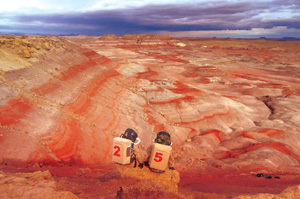 Inside the habitat—or Hab as they called it—the crew, consisting of commander John
Reynolds, executive officer/crew journalist Derek Pelland, crew geologist April Davis,
crew engineer Erick Tijerino, crew scientist Nora Swisher, and crew astronomer Diane
Turnshek, shared a split- level space the size of an average living room. The top
level was divided into two areas: one that housed six bedroom cells and another that
contained the kitchen and the crew’s workspace. The bottom level was divided between
the engineering hatch, toilet room, shower room, and the science lab containing equipment,
tools, and the crew’s space suits. “When you’re stuck in a space capsule with six
people, you’re either best friends or you really hate that person,” laughs Pelland.
“We were pretty close in there, and it definitely got a little closer for some people
who weren’t so used to it. Fortunately, I’ve been stuck in much tighter quarters that
were a lot more uncomfortable with much less food and electricity.”
Inside the habitat—or Hab as they called it—the crew, consisting of commander John
Reynolds, executive officer/crew journalist Derek Pelland, crew geologist April Davis,
crew engineer Erick Tijerino, crew scientist Nora Swisher, and crew astronomer Diane
Turnshek, shared a split- level space the size of an average living room. The top
level was divided into two areas: one that housed six bedroom cells and another that
contained the kitchen and the crew’s workspace. The bottom level was divided between
the engineering hatch, toilet room, shower room, and the science lab containing equipment,
tools, and the crew’s space suits. “When you’re stuck in a space capsule with six
people, you’re either best friends or you really hate that person,” laughs Pelland.
“We were pretty close in there, and it definitely got a little closer for some people
who weren’t so used to it. Fortunately, I’ve been stuck in much tighter quarters that
were a lot more uncomfortable with much less food and electricity.”
In his free time, Pelland was the resident cook, experimenting with the various dehydrated
goods they were allotted: vegetables, fruits, eggs, milk, apples, spices, and bouillon.
“We also had a big can of dehydrated nacho cheese-flavored sauce that I used for a
lot of different things to spice up the food. I made a lot of soups and pastas and
we had fresh bread every day,” he remembers.
Back on Earth, Pelland has begun his next mission: as a human rights officer in the
Office of High Commissioner for Human Rights at the United Nations in Geneva, Switzerland.
There he’s working on drawing attention to current human rights proposals to help
develop influence to take action while current issues are still relevant. “I am always
on the lookout for new positions to work with NGOs internationally,” he says. He hopes
to continue working on the MDRS in the next development stages, especially those in
the Arctic Circle in Canada and Antarctica, but will never forget the first time he
got a taste of life in space.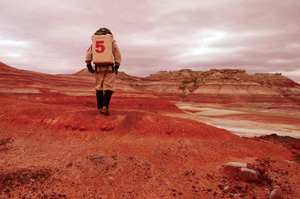 “I jumped into a situation that I knew would be difficult—I took it as a competitive
challenge, knowing that in the end I was going to make it work,” Pelland reflects.
“It all started with the moment I found out I could go to Mars. My life kicked into
overdrive and started moving forward for me. It gave me an opportunity to be prepared
for being unprepared. I haven’t had a second to recover, but I like it like that.”
“I jumped into a situation that I knew would be difficult—I took it as a competitive
challenge, knowing that in the end I was going to make it work,” Pelland reflects.
“It all started with the moment I found out I could go to Mars. My life kicked into
overdrive and started moving forward for me. It gave me an opportunity to be prepared
for being unprepared. I haven’t had a second to recover, but I like it like that.”
